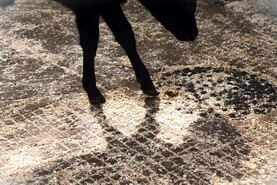Over the past few weeks, the calf-rearing series has looked at most aspects of the rearing phase of dairy beef systems, from entire system budgets and financials, genetics, calf housing, and creating the perfect environment for calf rearing.
All of these articles can be found online at www.ifj.ie/thrive.
The final week looks at pulling the entire system together in terms of production targets.
Dairy beef has the potential to leave a decent return for farmers, but animal performance must be good from a largely grass-based diet.
Measuring performance
Monitoring performance at key times throughout the system means periods of underperformance can be identified and dealt with at the earliest possible time. While it may not be able to be rectified for this batch of stock, at the very least you will know for the next year where you went wrong and what to do to improve.
Ideally, cattle need to be weighed at weaning, mid-season at grass year one, at housing for winter, mid-winter, at turnout to grass year two, mid-season in the second grazing and then more regularly as animals come close to slaughter. Or, where stock are to be slaughtered out of the shed at 24 months, they need to be weighed at rehousing and then regularly in the weeks prior to drafting. Whichever system you employ, stock should be weighed between six to eight times.
While this sounds like a lot of work, most of the weighing can coincide with other routine work that involves stock going through the crush anyway.
The importance of these weighings cannot be overemphasised. The top performing farms all weigh stock regularly as it is the only sure way to know that they are performing.
Rearing phase: The target growth rate from arrival to weaning off milk should be 0.7kg/day to 0.8kg/day. While this seems quite low, in reality, many calves are failing to hit these numbers.
First grazing season: Average daily gain for the first season at grass should be 0.85kg/day. With many farmers not weighing calves at weaning it results in estimated weights being used which skews average daily gain over the entire first season at grass. This leaves the farmer not knowing if it was the rearing or the grazing that failed to live up to expectations.
In the Thrive dairy calf to beef programme blueprint, there is a target housing weight for the first winter of 260kg for bullocks and 240kg for heifers in early November. This is for early-March born calves. Where your calves’ date of birth is after 10 March, take 5kg liveweight off the expected housing weight for every week after this date that calves are born.
First winter: Over the first winter is where a lot of stock will fall behind target and fail to reach a suitable slaughter age at the end of the second grazing season. A daily liveweight gain of 0.65kg/day to 0.8kg/day is needed during this period. The lower target is for a 24-month system whereas for those aiming for slaughtering stock off grass at 18 to 21 months, the higher first winter growth rate is required in order to have a sufficient carcase weight at the point of slaughter.
This winter performance needs to be coming primarily from high-quality grass silage that is at least 70% DMD, and ideally 75% DMD. This will need to be combined with a low level of concentrate feed.
Where high-quality grass silage is not available, the level of concentrate feeding required to support this weight gain is not going to be economically viable.
Second grazing season: A target turnout date of 10 March has been set in the blueprint. For drier and earlier farms this date may come sooner while on heavier farms it will likely be later. Aim to get the lightest stock out first, as early as possible. The target weight for bullocks at turnout is 362kg while for heifers it is 342kg. As this is their birth date it represents an average daily gain of between 0.8kg/day and 0.85kg/day for the first year of life.
With excellent grassland management, you would expect super performance in the second grazing season. There will be periods where they are doing 1.2kg/day to 1.3kg/day, typically earlier in the grazing season. However, over the last three years on the Thrive demonstration farm, on a grass-only diet from turnout until early August, bullocks have averaged 1.05kg/day with heifers at 0.92kg/day.
On the demo farm, from early August the most forward of stock will start to receive a low level of concentrate feeding at pasture for three to six weeks depending on the level of flesh they are in. Regular drafting takes place at each production stage based on the Thrive demo farm dairy beef blueprint.
The aim is to have heifers at least 500kg liveweight at drafting. Last year the finishing cattle were rehoused due to a shortage of grass, however, in 2021 the average draft weight from grass for heifers was 521kg while for the bullocks it was 597kg. It resulted in an average carcase weight of 268kg and 309kg for heifers and bullocks respectively.
In a 24-month system, meal feeding would not be introduced until much later in autumn and would depend on grass quality and availability.
Indoor finishing: Again, indoor finishing of these animals needs to be based on very high-quality grass silage combined with some concentrate feeding. Where traditional breeds are being used, there should be no issue in achieving the minimum carcase fat score even at low concentrate levels.






 This is a subscriber-only article
This is a subscriber-only article










SHARING OPTIONS: